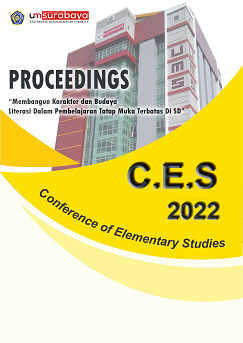PENGARUH MODEL PEMBELAJARAN PROBLEM BASED LEARNING DAN GAYA BELAJAR AUDITORIAL TERHADAP HASIL BELAJAR DI SEKOLAH DASAR
Abstrak
In this study, the researcher examines the effect of the Problem Based Learning model and the Auditorial Learning Style of students on student learning outcomes in grade IV Elementary School. The method used in this research is an experimental method with a quantitative approach. The independent variables in this study are Problem Based Learning (X1) and Auditory Learning (X2) learning models. The dependent variable in this study is student learning outcomes (Y). The sample population in this study included all fourth grade students at SD Banyu Urip, totaling 34 students. The results in this study indicate that the use of the Problem Based Learning Method has a significant influence in efforts to improve student learning outcomes with an average ratio of 82.44. While student learning styles also affect the increase in the value of student learning outcomes with an average value ratio of 70.4. Judging from the results of this study, it can be concluded that learning by applying the Problem Based Learning Method and Auditory Learning Style has little impact on the high student learning outcomes in learning Natural Sciences and is included in the size criteria in the medium category.
Â
Keywoard: auditory learning style; learning outcomes; learning model; problem based learning;
Referensi
Anonim (2019) ‘Bab II Landasan Teori’, Journal of Chemical Information and Modeling, 53(9), pp. 8–24.
Assegaff, A. and Sontani, U. T. (2016) ‘Upaya Meningkatkan Kemampuan Berfikir Analitis Melalui Model Problem Based Learning (Pbl)’, Jurnal Pendidikan Manajemen Perkantoran, 1(1), p. 38. doi: 10.17509/jpm.v1i1.3263.
Basuki, K. (2019) ‘Metode Pembelajaran Bridwatching; Prestasi Belajar IPA; Learning Method Bridwatching ; Science Learning Achievement’, ISSN 2502-3632 (Online) ISSN 2356-0304 (Paper) Jurnal Online Internasional & Nasional Vol. 7 No.1, Januari – Juni 2019 Universitas 17 Agustus 1945 Jakarta, 53(9), pp. 1689–1699. Available at: www.journal.uta45jakarta.ac.id.
Dan, A. and Yang, F. (2018) ‘STUDY ABOUT STUDENT LEARNING ACHIEVEMENT ASPECT AND’, 2(2), pp. 115–123.
Dan, B. et al. (2020) ‘Jurnal Bimbingan dan Konseling Ar-Rahman Universitas Islam Kalimantan Muhammad Arsyad Al-Banjari Banjarmasin’, 6, pp. 29–32.
Hasil, T., Ips, B. and Smp, S. (2016) ‘Jurnal Dimensi Pendidikan dan Pembelajaran Vol.5 Januari 2016 | 9’, 5, pp. 9–16.
Ina Fitriyana, 2010: 11 (2010) ‘Kajian Teori IPA’, pp. 16-47
Kurniawan, M. R. (2017) ‘ANALISIS KARAKTER MEDIA PEMBELAJARAN BERDASARKAN GAYA BELAJAR PESERTA DIDIK Proses pembelajaran merupakan sebuah sistem yang terdiri dari berbagai Kedudukan media pembelajaran dalam sistem pembelajaran mempunyai pembelajaran diantaranya adalah melalui pasif learning ke aktif learning semakin penting ( Tejo Nurseto , 2011 : 20 ). dominasi guru di kelas . Peran guru tersampaikannya pesan , proses komunikasi . Secara umum komunikasi’, 3, pp. 491–506.
Kustiani, L. and Hariani, L. S. (2018) ‘Faktor-Faktor Yang Mempengaruhi Hasil Belajar Siswa’, 12(1), pp. 14–22.
Mudjiono, D. dan (2009) Rineka Cipta. Jakarta.
Nofriansyah, N., Pernantah, P. S. and Riyadi, S. (2022) ‘Gaya Belajar Peserta Didik Berprestasi’, Edukatif : Jurnal Ilmu Pendidikan, 4(1), pp. 1565–1574. doi: 10.31004/edukatif.v4i1.1899.
Pendidikan, J., Vol, P. and Homepage, J. (2021) ‘1) , 2) 2)’, I(I), pp. 86–95.
Riadi, A. (2016) ‘Problem-based learning meningkatkan higher-order thinking skills siswa kelas VIII SMPN 1 Daha Utara dan SMPN 2 Daha Utara’, Math Didactic: Jurnal Pendidikan Matematika, 2(3), pp. 154–163. doi: 10.33654/math.v2i3.44.
Sywi, G. S., Jalmo, T. and Rita, R. (2015) ‘Pengaruh Problem Based Learning dalam Meningkatkan Self-Efficacy dan Hasil Belajar’, Jurnal Bioterdidik: Wahana Ekspresi Ilmiah, 3(10), pp. 10–18. Available at: http://jurnal.fkip.unila.ac.id/index.php/JBT/article/view/9784.
Tarigan, E. B. et al. (2021) ‘Peningkatan Hasil Belajar Siswa dengan Menggunakan Model Problem Based Learning pada Pembelajaran Tematik’, Edukatif : Jurnal Ilmu Pendidikan, 3(4), pp. 2294–2304. Available at: https://edukatif.org/index.php/edukatif/article/view/1192.






